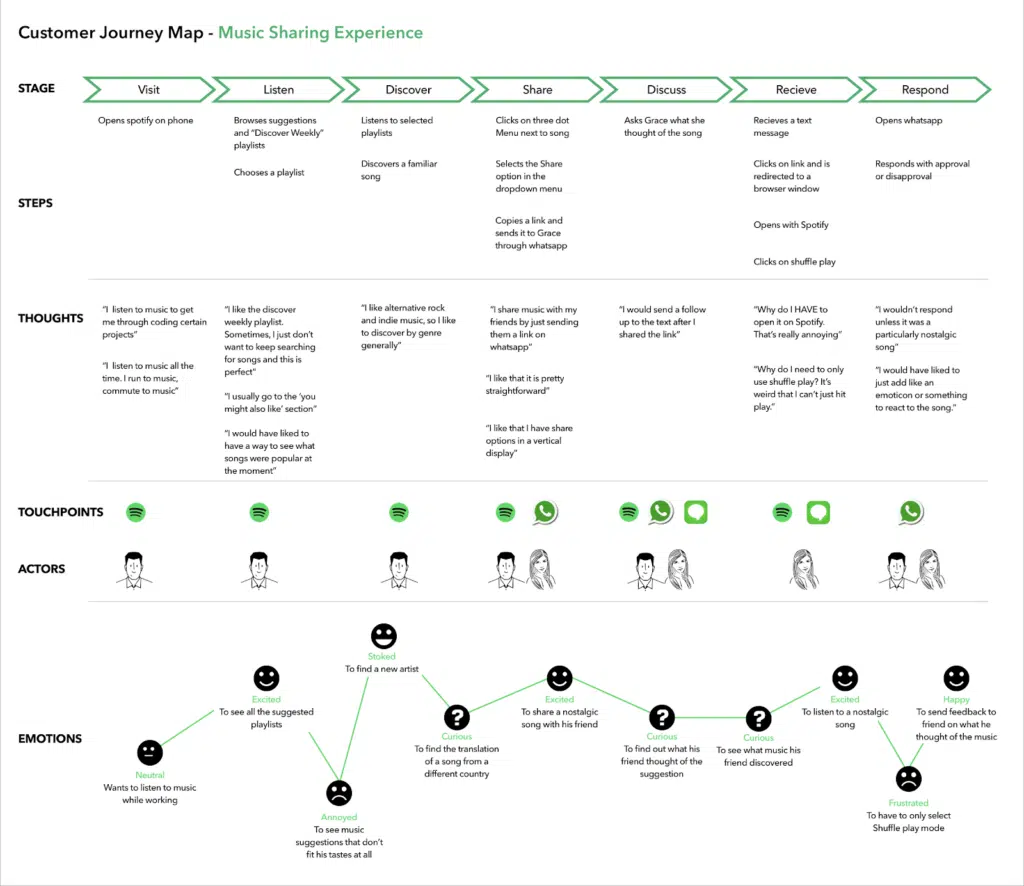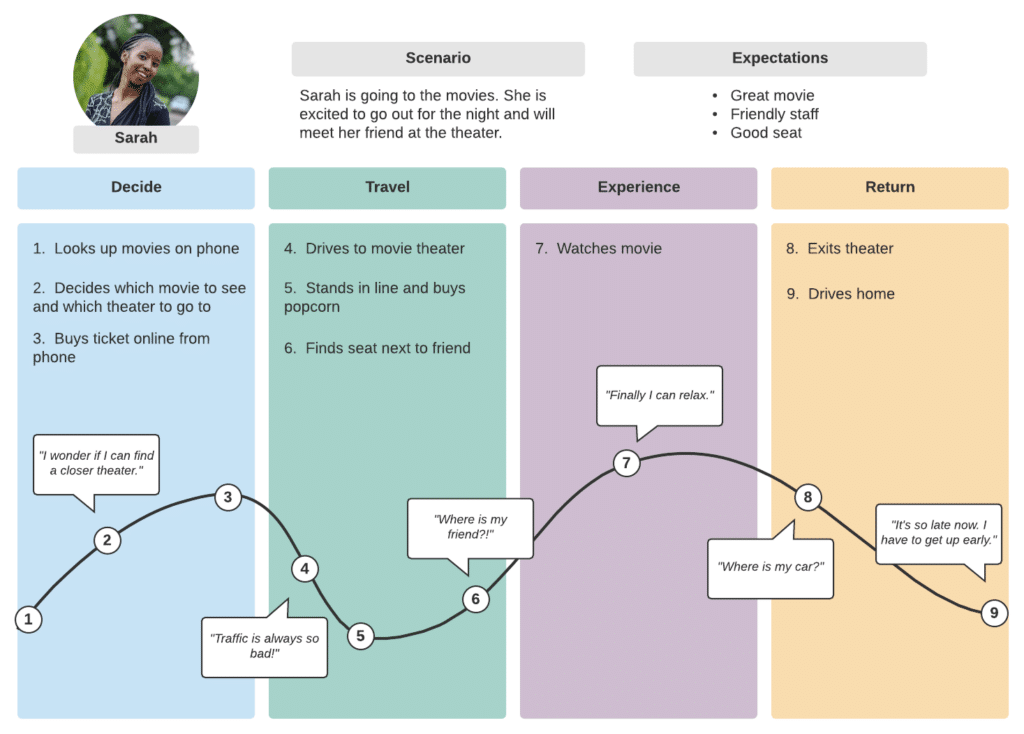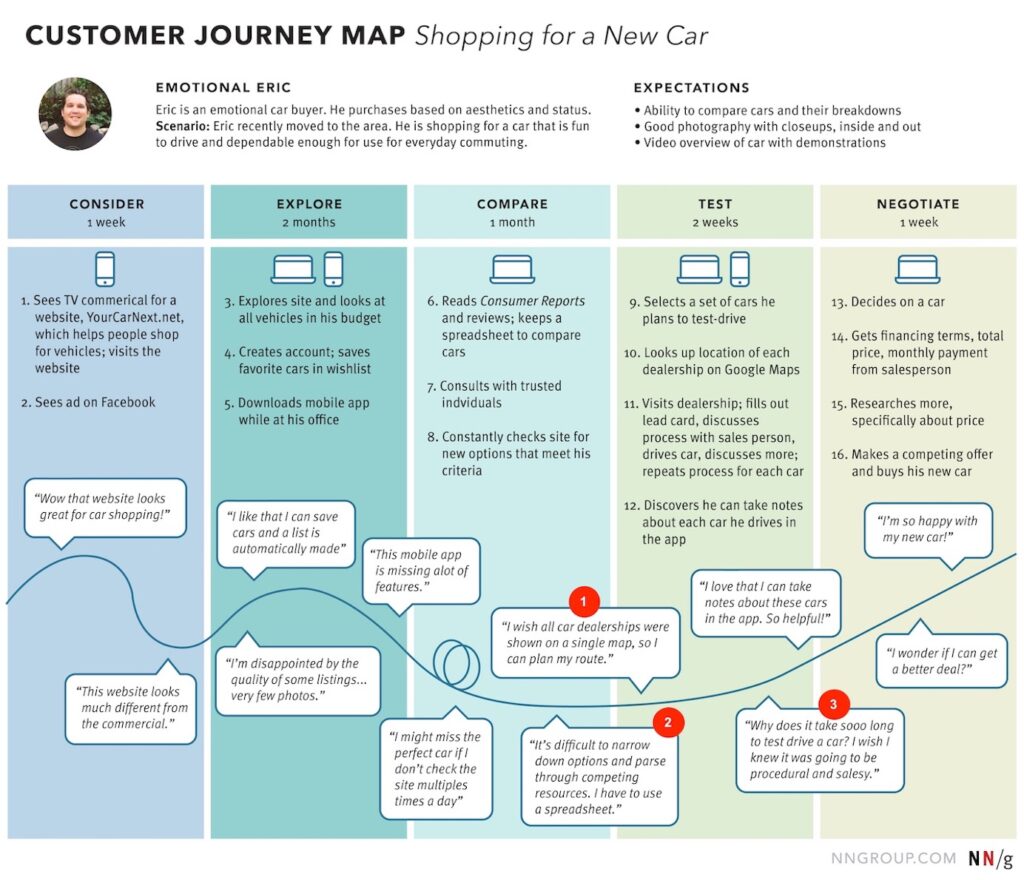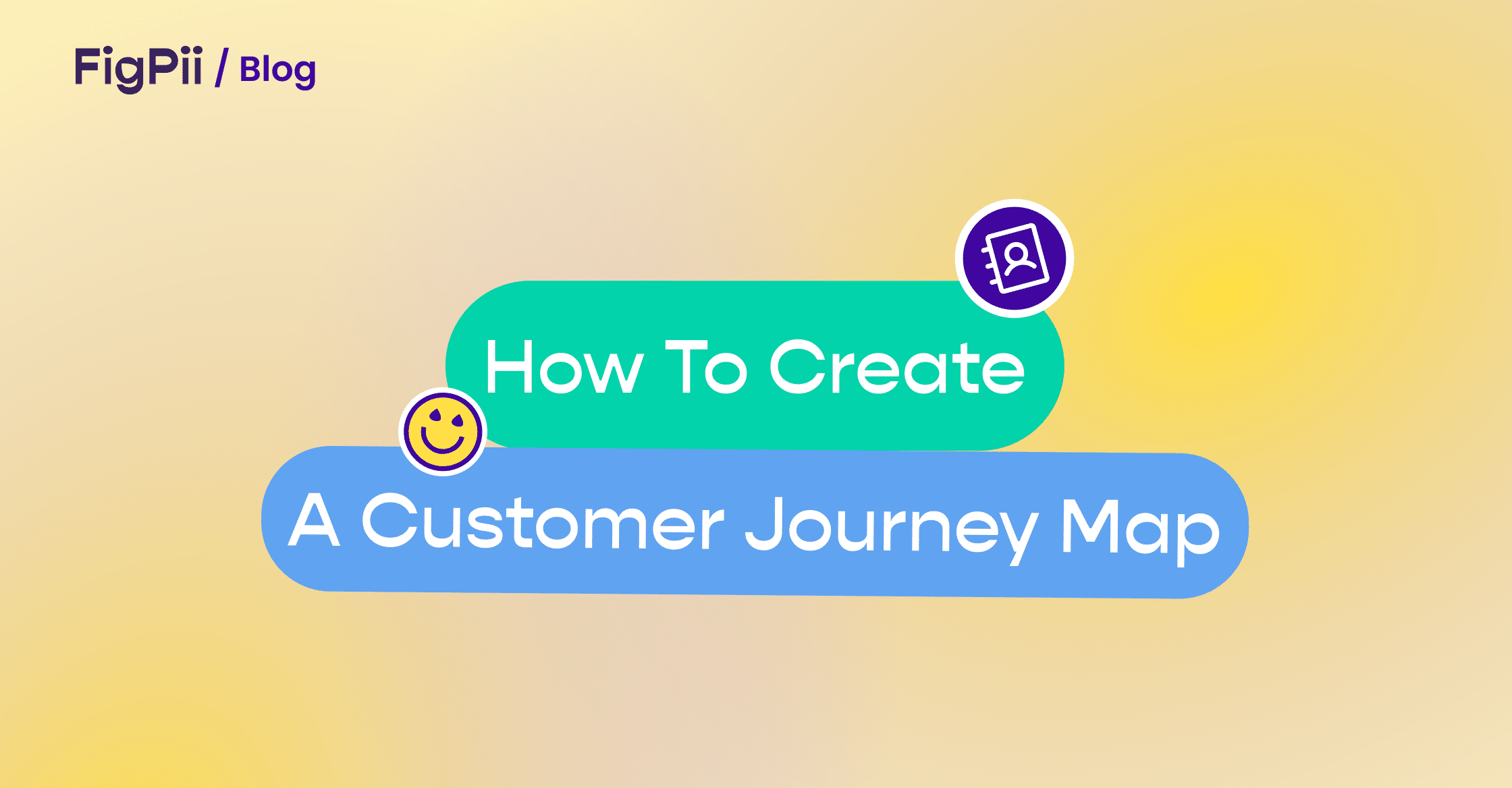As many as 86% of buyers are willing to pay more for a great customer experience.
In today’s hyper-competitive business world, creating an exceptional customer journey has become more critical than ever.
But where do you start?
The answer lies in customer journey mapping, a process that helps businesses better understand their customers’ needs, preferences, and pain points.
The customer journey is the path a customer takes, from discovering your brand to becoming a loyal customer. It’s essential for businesses to understand their customers’ journey and how they can help them along it.
In this guide, we’ll take a deep dive into customer journey mapping, sharing tips, tricks, and real-world examples to help you create a successful customer journey map that delivers results.
Step 1. Market research and data gathering
Research and data gathering is the first step in creating a customer journey map. This involves identifying your target audience, understanding their needs and wants, and learning about their buying behaviors.
Here’s how you can do that:
Identifying the target audience
The first step in creating a customer journey map is identifying your target audience. This does not mean you have to have an exact number of people, but it does mean that you need to clearly define the types of customers who will be using your product or service.
For example, if you’re building a new website, you should know how many people will visit the site each month and where they are coming from (i.e., search engine results pages, social media sites, etc.).
Or, if you want to create a customer journey map for a new mobile application, you’ll want to know the age range and gender of those who will be using it most frequently.
Identifying your target audience might require some research on your part. Here are some tips to help you identify your target audience:
- Ensure that everyone involved in creating the customer journey map understands what type of customers they are trying to attract before starting any research or data-gathering activities.
- Ask questions like Who are our customers? What do they need from us? Why should we care about them? How can we improve our products or services to meet their needs better?
- Look at your existing customers. What kind of jobs do they do? What are their ages? Do they have children? Where do they live?
- Look at your competitors’ customers. Who uses their products or services? How much money do they make? What kind of education did they get?
Don’t forget to use social media to discover more about people similar to those you already know.
Sites like Facebook and LinkedIn allow you to search for specific groups of people based on their interests and demographics – such as age, gender, location, and career path. These sites also allow you to see what someone has liked or shared online, giving content ideas and insight into what motivates them as consumers.
Analyzing customer behavior
As with any other type of analysis, it’s essential that you understand your audience before you begin mapping their journeys. You need to know who they are, how they behave, and what they want.
This also includes identifying customer goals, challenges, and pain points.
You also need to understand how all of this relates to your product or service so that you can identify key touchpoints in the customer experience.
This means looking at the factors that influence their decision-making process.
In the example of the customer journey map below, Spotify identifies pain points and addresses them to create a smoother music-sharing experience. They analyze customer behavior through research and surveys to understand users’ emotions at each stage.
(Source)
Customer behavior will help you identify the touchpoints where customers engage with your brand, the channels they use to interact with you, and the motivations and needs that drive their behavior.
Once you’ve identified these motivators, you can also use them as a guide throughout the rest of the process to create your customer journey map.
There are several ways you can conduct this analysis:
- You can use surveys and questionnaires to understand how users think about your product or service, what they like about it, and what they don’t like about it. You can learn a lot about them by creating online surveys, interviews, and other research methods.
- You can collect customer feedback via social media channels such as Facebook, Twitter, and LinkedIn. Remember that using social media for collecting feedback has its own challenges, so make sure you clearly understand what people are saying before jumping into the fray.
- You can observe customers as they use your product or service to identify any issues that arise (e.g. if users are having trouble using certain features).
In addition, you can use heat map tools like FigPii on your website. Heat maps help you analyze customer behavior by giving insights into where they’re clicking, how far they’re scrolling, distraction points, frustration signals, and the like.
The image below represents a website heat map, where warm colors indicate high user activity and cool colors represent minimal interaction.

(Source)
You can even run A/B tests using FigPii by changing things like the copy on your website or adding an incentive for people to sign up for an email list – then measuring how this affects things like conversion and churn rates.
Creating customer personas based on the above research
The next step is to create customer personas based on your target audience and customer behavior research.
For the uninitiated, target customer personas are fictional characters that represent different segments of your customer base. For example, if you’re targeting millennials, you might have one persona for single mothers and another for young couples starting out in their careers.
You can use these personas to identify each group’s needs and challenges as part of their journey with your brand and their language when discussing your business.
For each persona, you should have a name, a photo, and some basic demographic information like age and gender. You can also use copy ai alternatives for possible ideas.

(Source)
In addition to this basic information, you should also include:
- The role they play in the buying process
- What they want to get out of the buying experience
- Why do they buy from you or your competitors (and why)
- What obstacles prevent them from buying from you or your competitors (and how can those obstacles be overcome)
Here’s an example of a customer journey map based on the customer persona’s experience:

(Source)
Step 2. Mapping the customer journey
So, you’ve identified your target audience and are ready to create a customer journey map.
The next step is to break down the customer experiences into different stages, like a journey through a magical land (minus the dragons).
This helps you visualize the customer experience from start to finish and identify key customer touchpoints where they can engage with customers and optimize the experience.
Let’s start by identifying the stages of a typical customer journey.
Identifying the different stages of the customer journey
To create a customer journey map, start by identifying where your customers are at different stages of their experience with you and what they’re doing at each stage. Use this information to create paths through the customer lifecycle that match up with how customers interact with your business.
For example, if you own a retail store, you might want to create a map that includes four phases: awareness and consideration; research; purchase decision; after purchase experience (including returns).
Here’s a quick overview of all the stages in the journey:
- Awareness: The customer becomes aware of the business, product, or service through channels like advertising, referrals, social media, etc.
- Consideration: They’ll evaluate your product or service at this stage and may compare it with other alternatives. This stage involves gathering information, reading reviews, and seeking recommendations.
- Purchase: The customer decides to purchase the product or service – whether it’s online or in-store.
- Onboarding: You introduce the customer to the product or service and provide the necessary information and resources to use it.
- Usage: The customer starts using the product or service and has ongoing interactions with the business, such as customer support or product updates.
- Retention: The customer develops loyalty towards the business, repurchases the product or service, and may refer it to others.
Here’s what a basic customer journey map template would look like:

(Source)
Once you identify different stages of your customer’s journey, dig deeper into customer interactions along each step (e.g., search engine results page, email newsletter, social media posts).
Next, map out who goes through each stage, how long it takes, and what factors influence them at each step along the way (e.g., price point).
Understand what motivates people at each stage (e.g., desire for convenience). Think about how people move from one phase to another (e.g., moving from “aware” to “considering” involves research and comparison shopping).
Once you’re aware of these details, it’s time to put it all together.
Creating a visual representation of the customer journey
The visual representation of your customer journey will include the customer’s experience with your product or service.
It should display:
- The path they take through their purchase decision
- How they interact with your brand
- Where they experience friction
- How you can improve each step to create a better experience for them.
You can use different shapes for each step, such as circles for awareness, squares for consideration, and triangles for conversion steps (purchase). You can also use color coding to break down the different stages – blue could mean awareness, red could mean consideration, and green could mean conversion.
Here’s a fictional ecommerce customer journey map that provides a visual overview of a typical day in a customer’s life.
This map not only depicts the customer’s interactions and feelings during their engagement with the company but also highlights all the emotions and actions that the customer undergoes throughout the day.

(Source)
This map basically gauges the customer’s frame of mind by evaluating how much they feel at ease or bothered by certain factors. By doing so, the company can better grasp what its target customers are stressed about or find problematic.
This information helps the company pinpoint its customers’ pain points and address them effectively. So, it’s a pretty useful tool for improving customer experience!
Step 3. Identifying opportunities for improvement
Analyzing pain points and areas for improvement
Now that we’ve mapped our customer journey, it’s time to analyze the data.
The key question you want to answer here is: how can we improve our customer experience?
To do this, you need to look at your customer journey map and identify areas for improvement.
You can do this by looking at the pain points in your customer’s experience and identifying opportunities for improvement.
Some of the ways to analyze a customer journey map are:
- Check where expectations are not met: Compare what users expect from your product or service with what they actually get and identify the gaps or mismatches.
- Find low and high points: Look for the points in the journey where users feel the most negative or positive emotions and understand why they occur.For example, you can analyze where Eric’s customer journey hit a low point during the Compare and Test phases of his car-buying experience.

(Source)
The car-buying site provided little help in comparing and narrowing down options, and the locations of the cars of interest were not shown on a single map. Additionally, the test-drive visits were longer than expected, catching him off guard.
- Enhance or avoid moments of truth: Identify the critical interactions that influence the user’s perception of your brand, product, or service and try to make them more positive or prevent them from happening.
- Use customer journey analytics: Track, measure, and analyze user behavior across different touchpoints and channels to quantify the impact of your journey map on key metrics such as conversion rates, customer retention rates, satisfaction scores, etc.
Step 4. Implementing and testing
Now that you’ve identified your customers’ pain points and areas for improvement, it’s time to start implementing them.
Implementing improvements and changes
After you’ve created your customer journey map, it’s time to start implementing some of the changes and improvements you identified.
Here are some steps you can take:
- Brainstorm possible solutions for each of these issues, such as changes to the website, better communication with customers, or streamlining processes.
- Prioritize the solutions based on their impact on the customer experience and their feasibility for implementation.
- Monitor the customer journey and collect feedback to see if the changes have made a positive impact.
- Eliminate or streamline the optional steps or take too much time or effort for users to complete their goals.
- Make sure that users can switch smoothly between different channels (such as web, mobile, email, phone, etc.) without losing information or context.
Continuously revisit and update the customer journey map as new pain points emerge or as the customer needs and expectations change over time.
Continuously testing and refining the customer journey map
The customer journey map should be a living document. As you conduct research and test your assumptions, you may need to make changes to your map.
Here are some ways you can improve your map:
- Test different messaging and calls to action to see which resonates best with customers.
- Update the customer journey based on what you learn from testing, such as when customers abandon the funnel or hesitate at a particular step.
- Use analytics tools like Google Analytics or FigPii to understand where most visitors are dropping off in your funnel and why this is happening so you can redesign it appropriately. They can help you gather data, conduct experiments, and iterate on the customer journey map.
Plotting the Path to Customer Delight: Create Killer Customer Journey Maps
In conclusion, creating customer journey maps is essential for understanding and improving the customer experience.
By mapping out the various touchpoints and emotions along the customer journeys, businesses can identify customer pain points, areas for improvement, and opportunities to delight customers. It’s important to involve cross-functional teams, gather data, and iterate on the map to ensure it accurately reflects the customer’s journey.
Ultimately, a well-crafted customer journey mapping process can help businesses create more meaningful, personalized experiences that drive customer loyalty and business growth.

